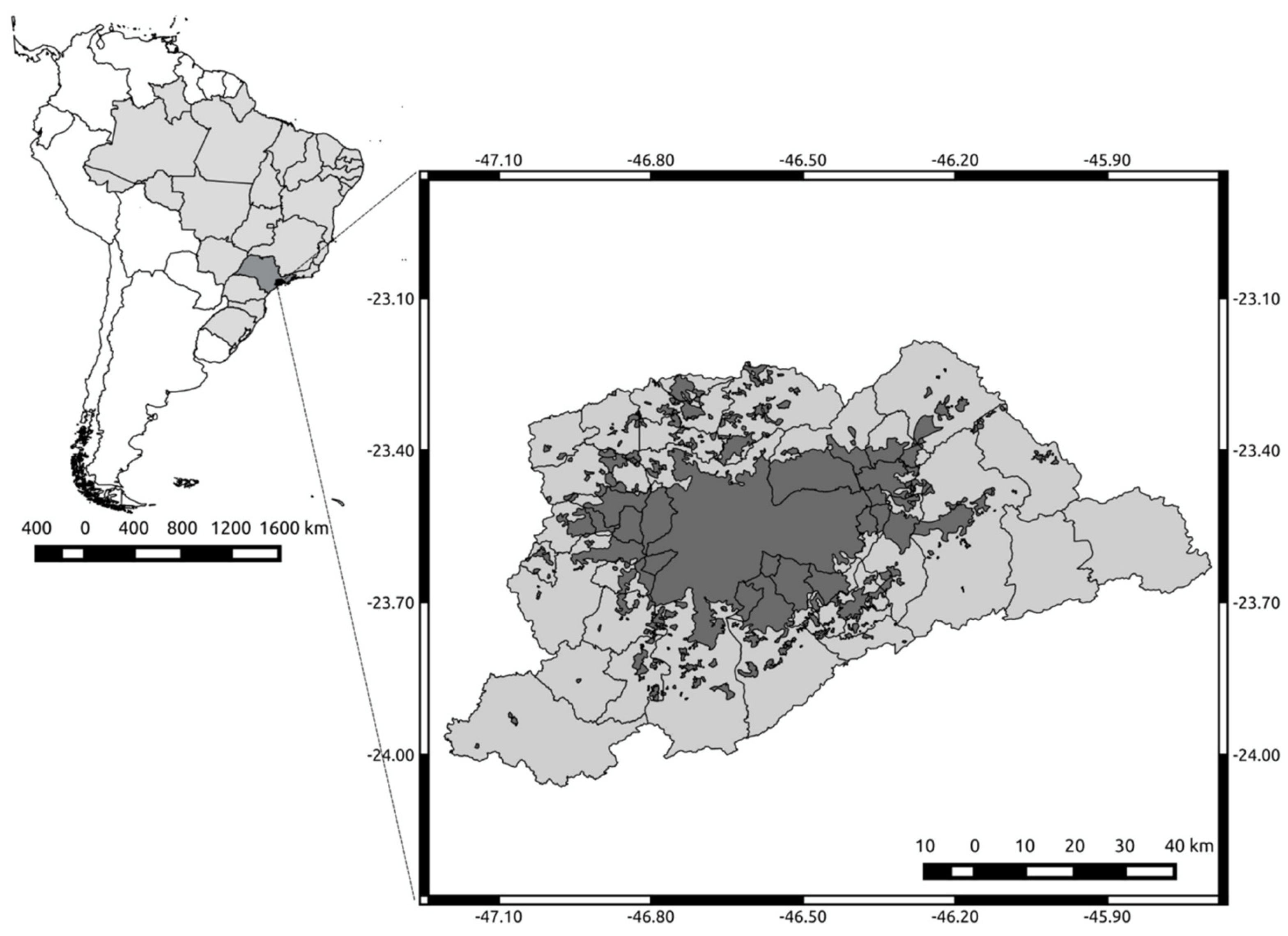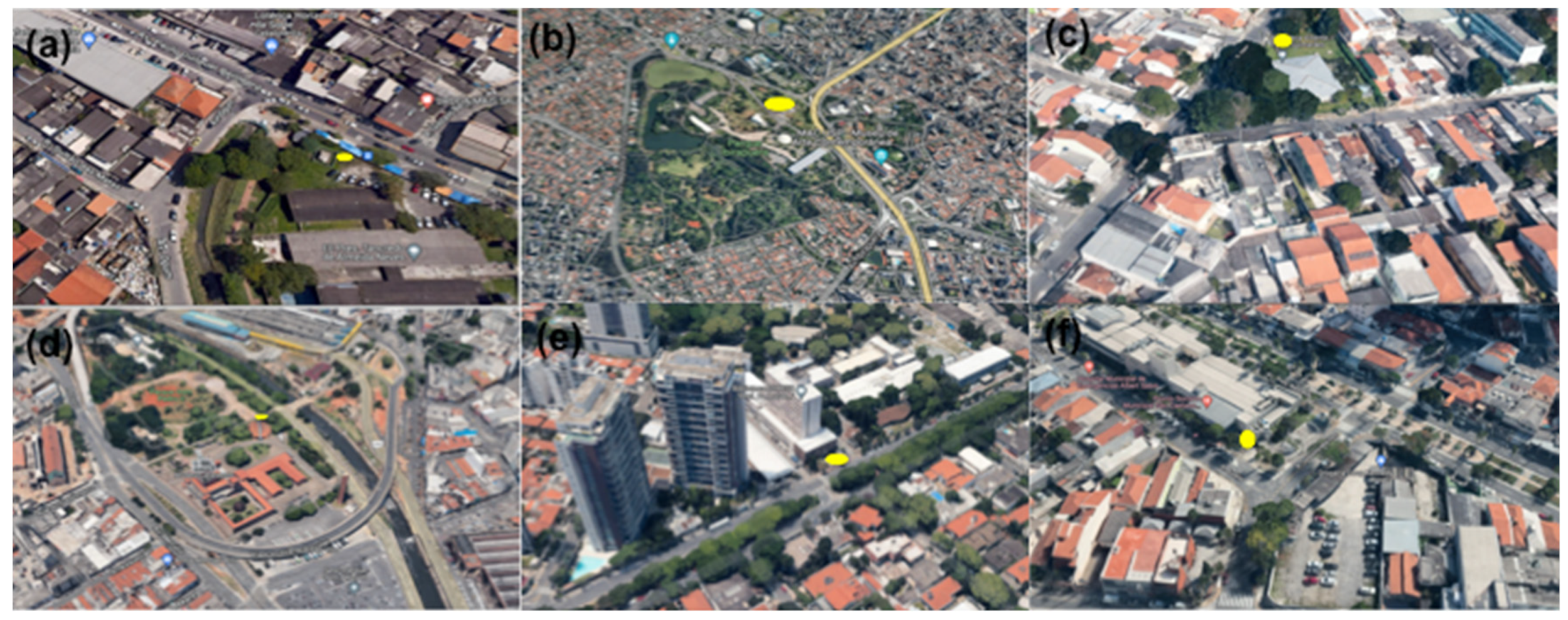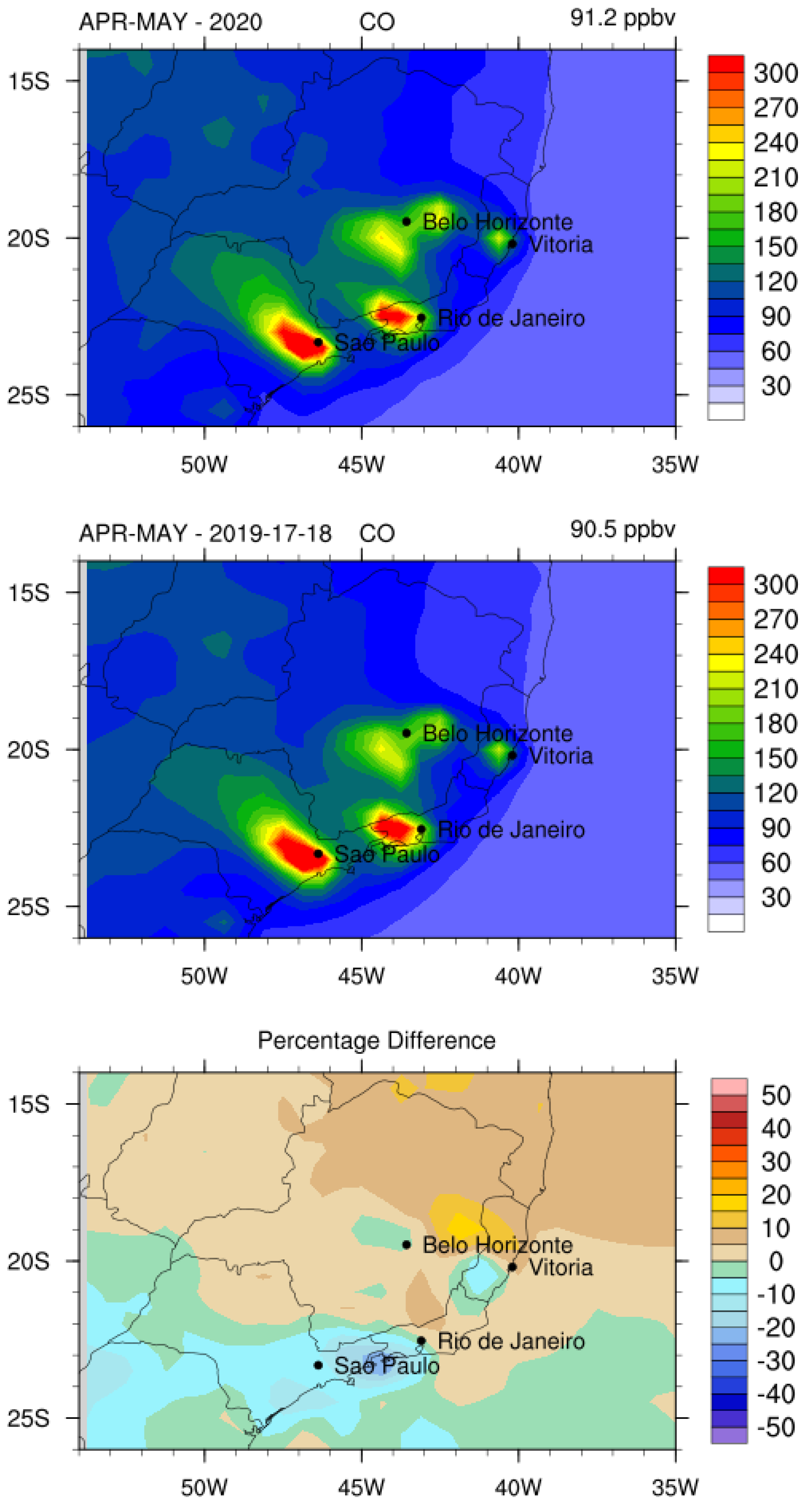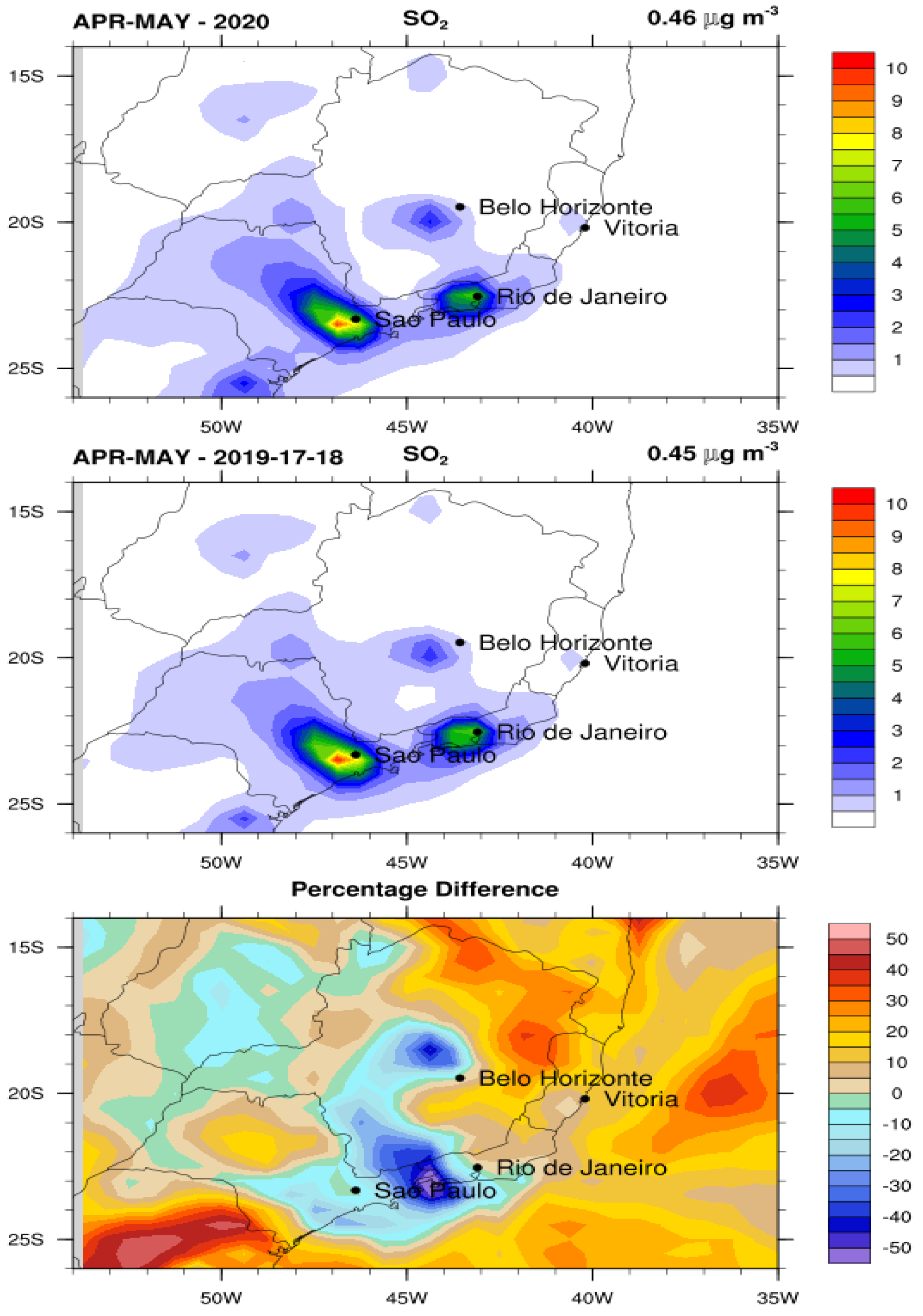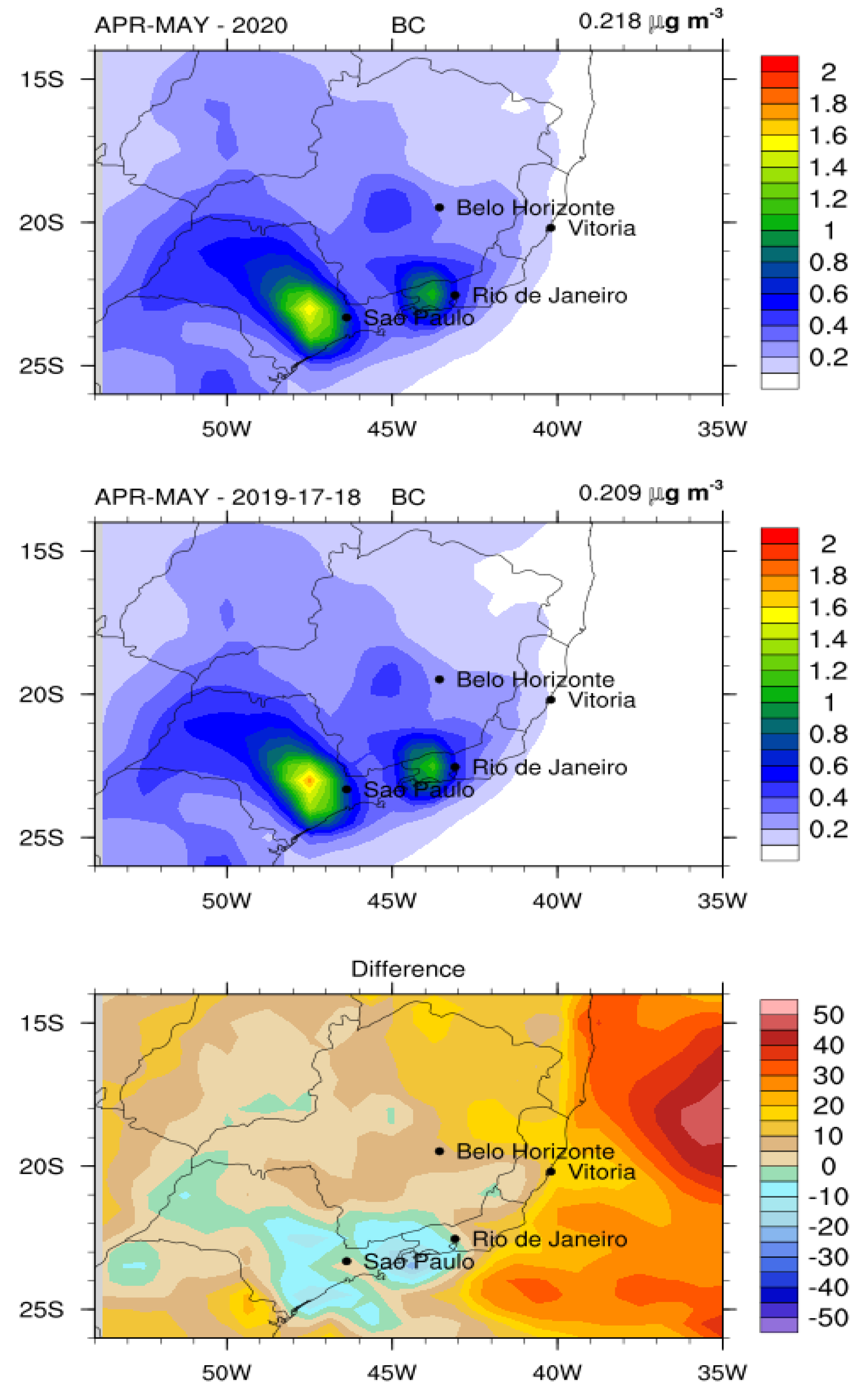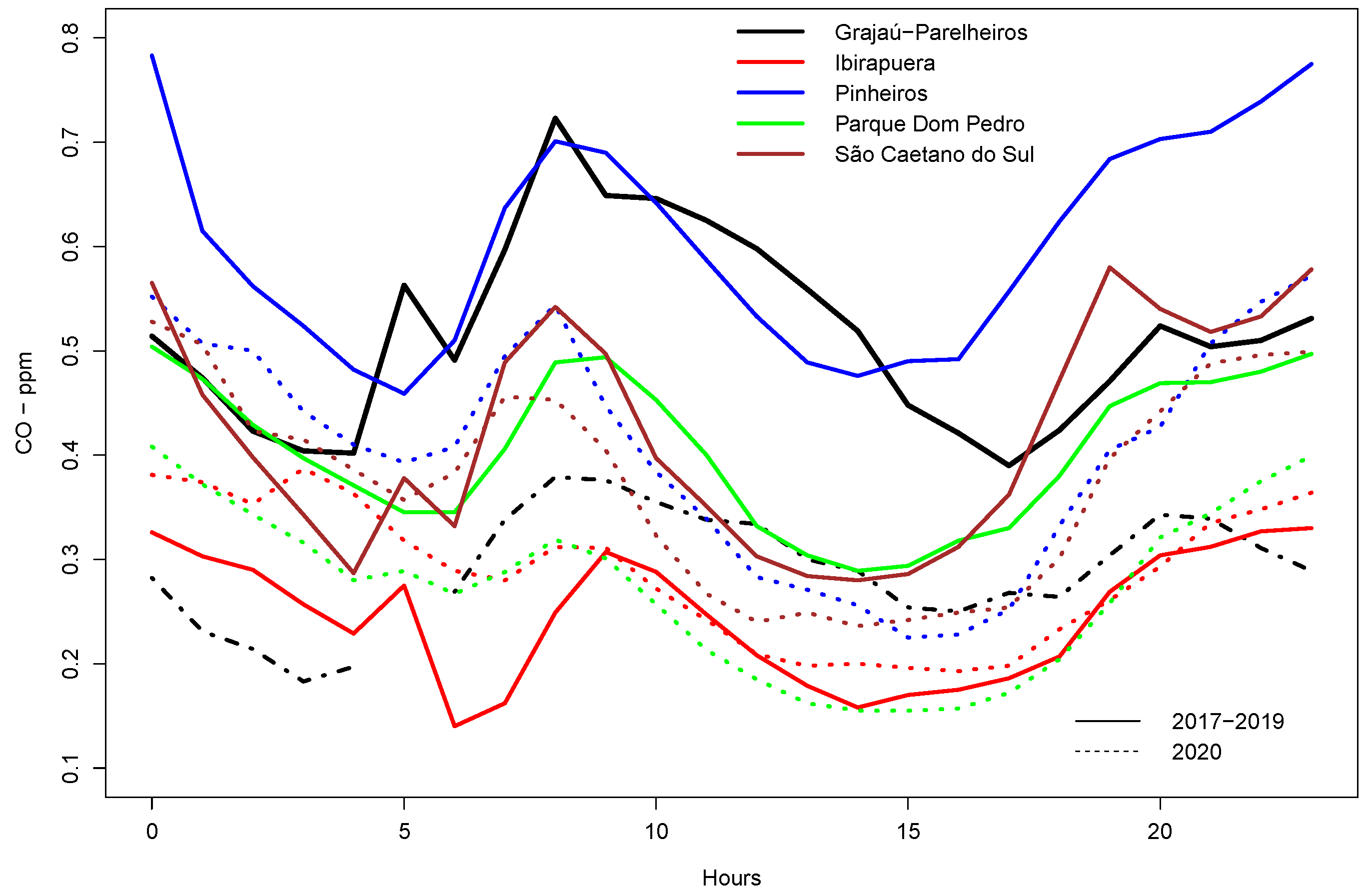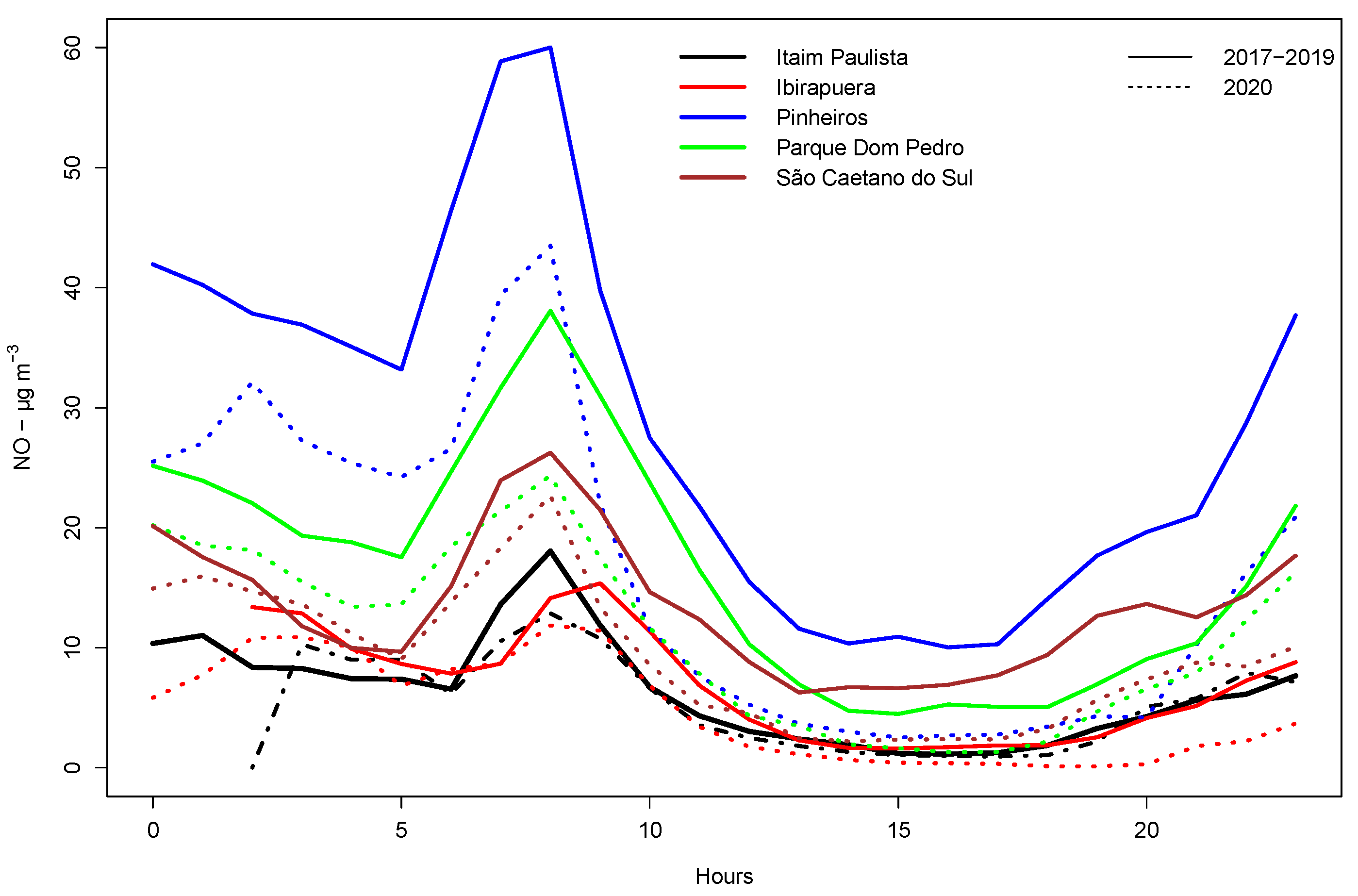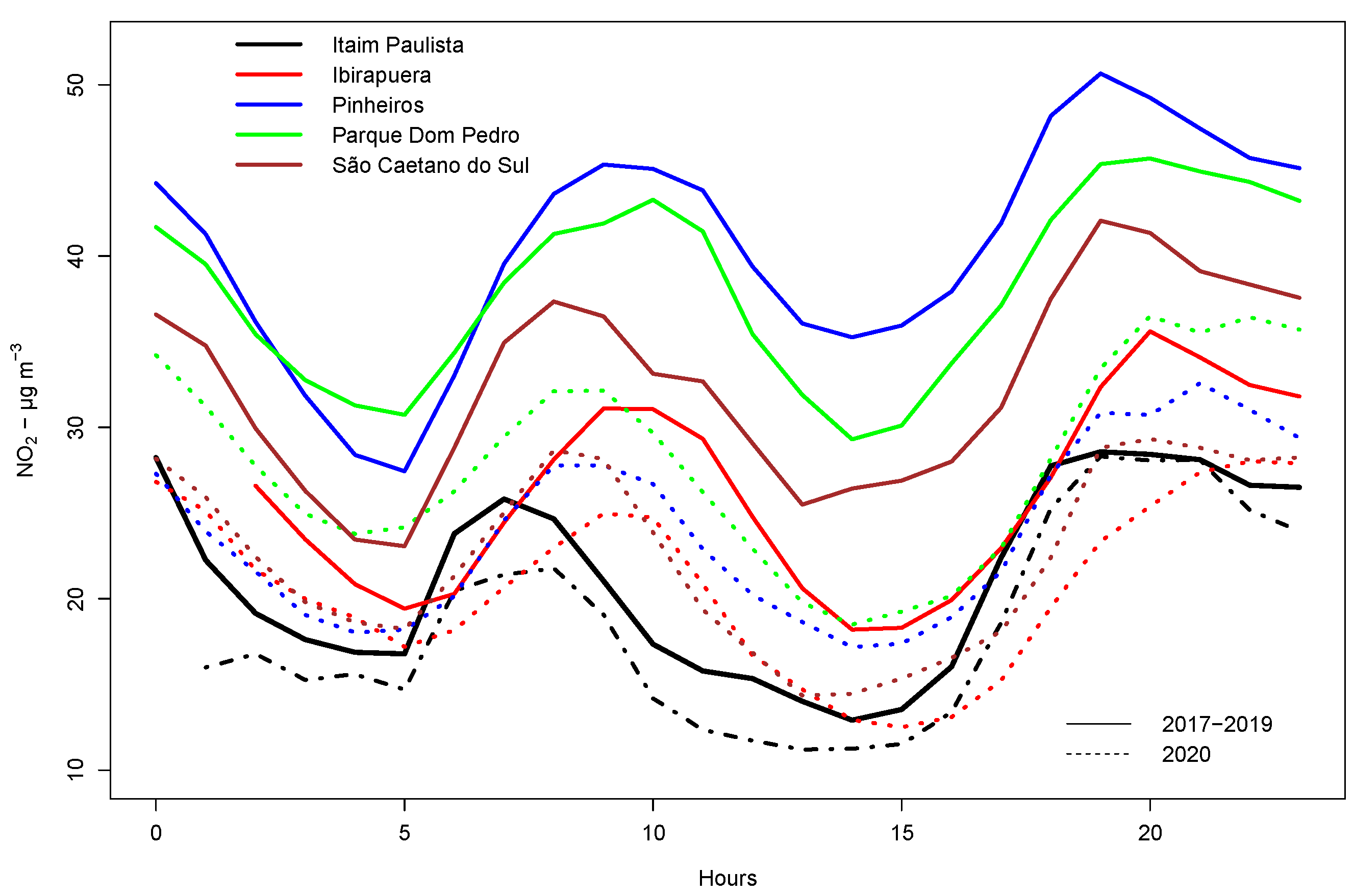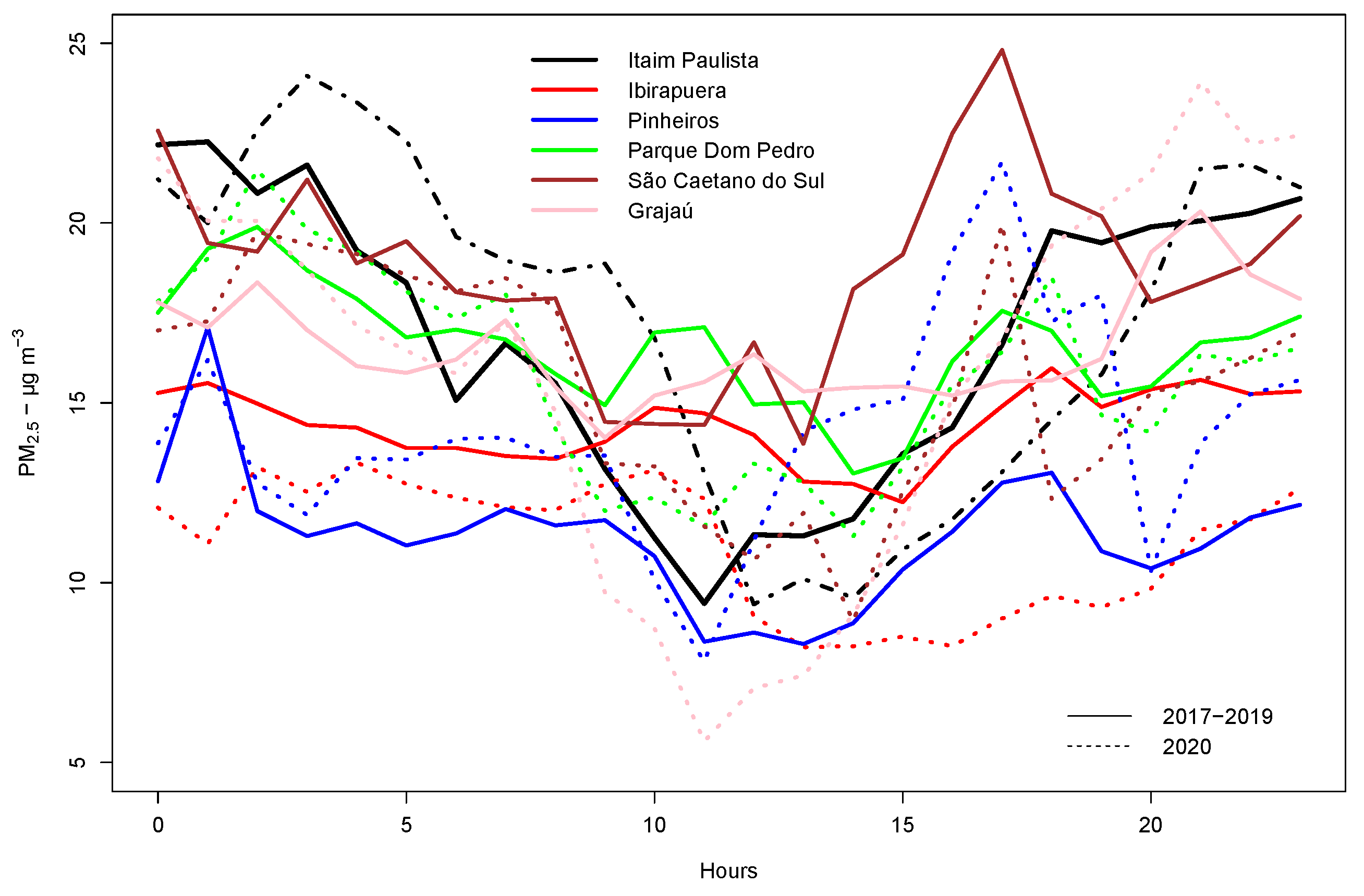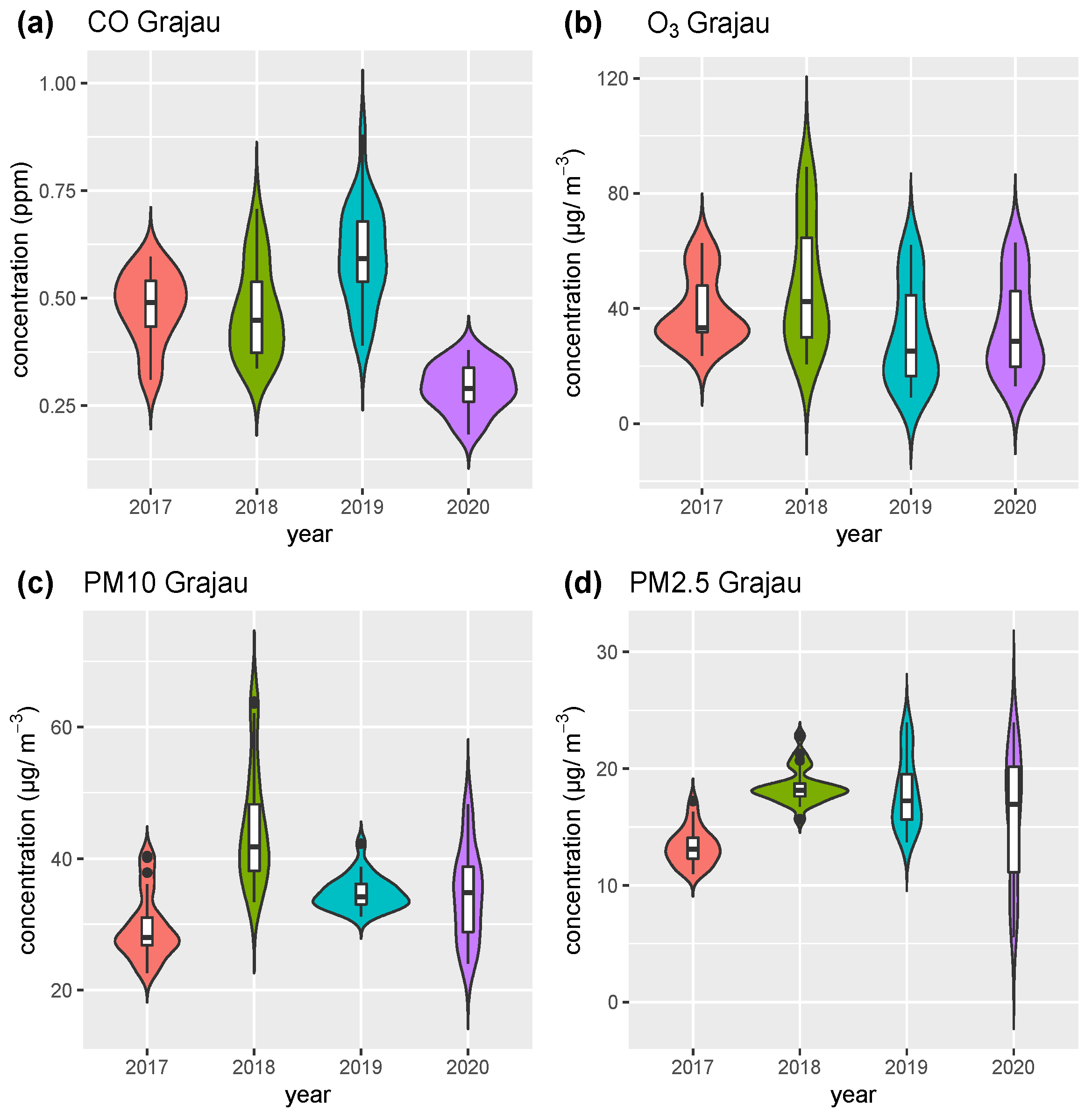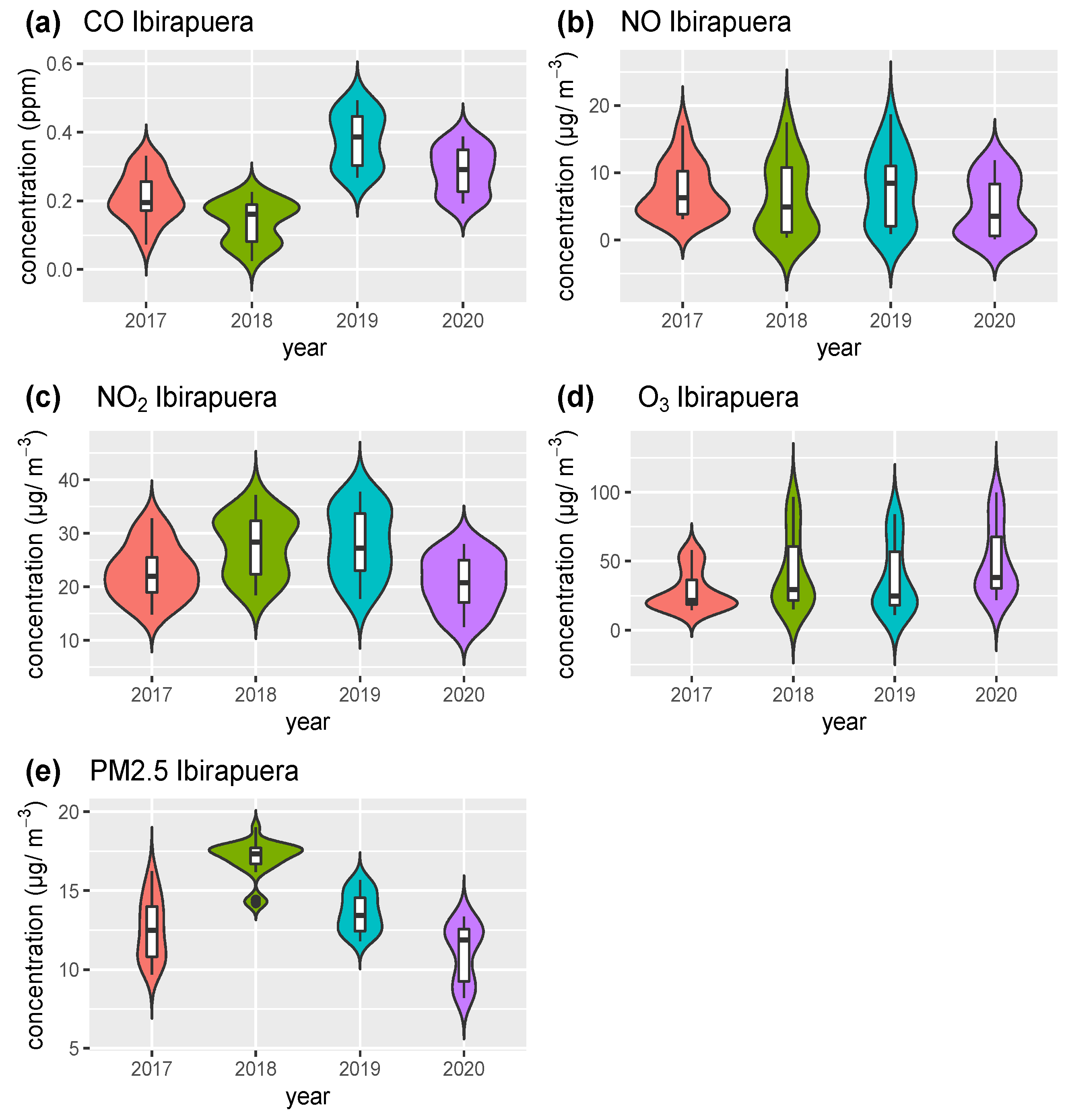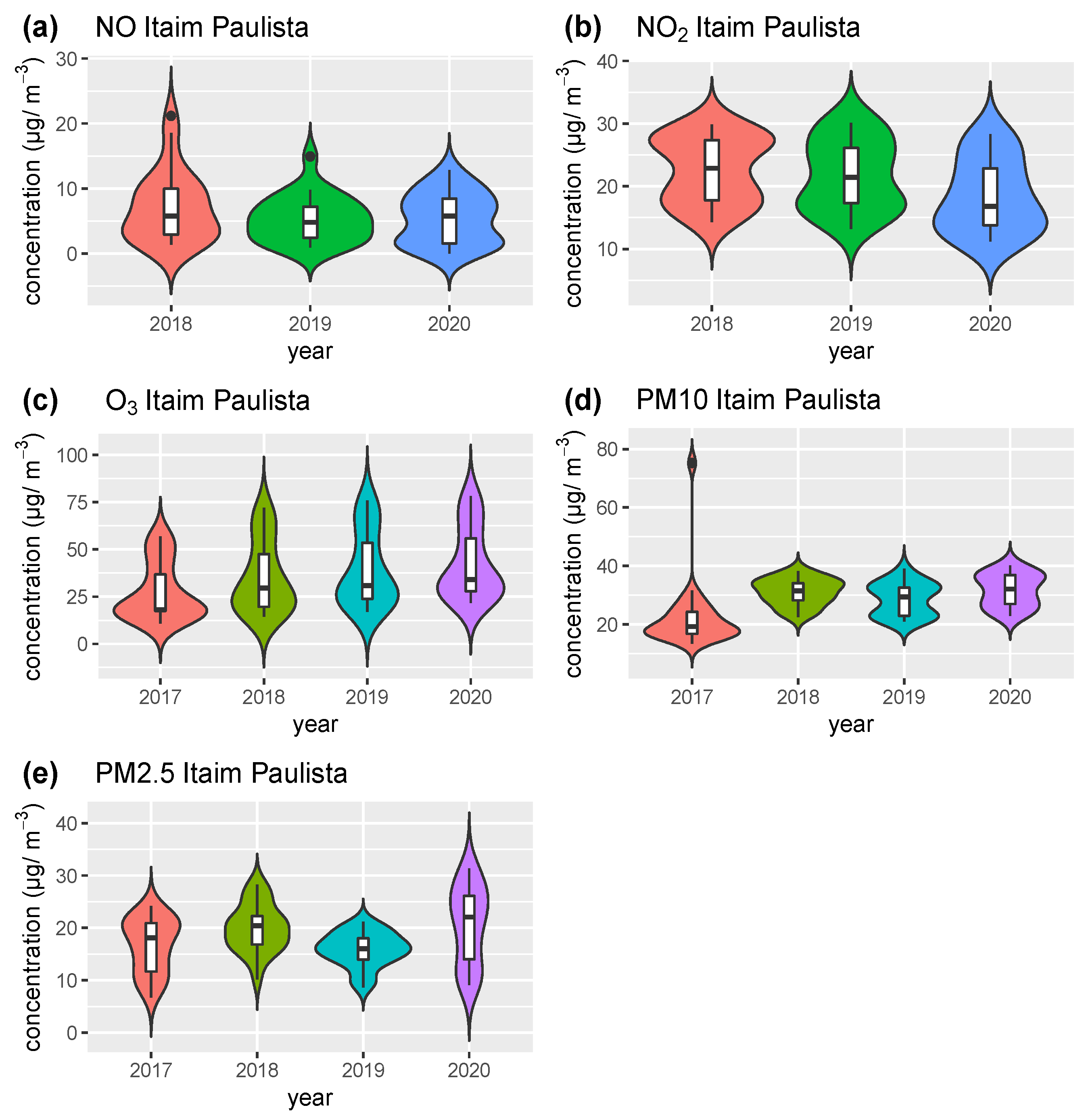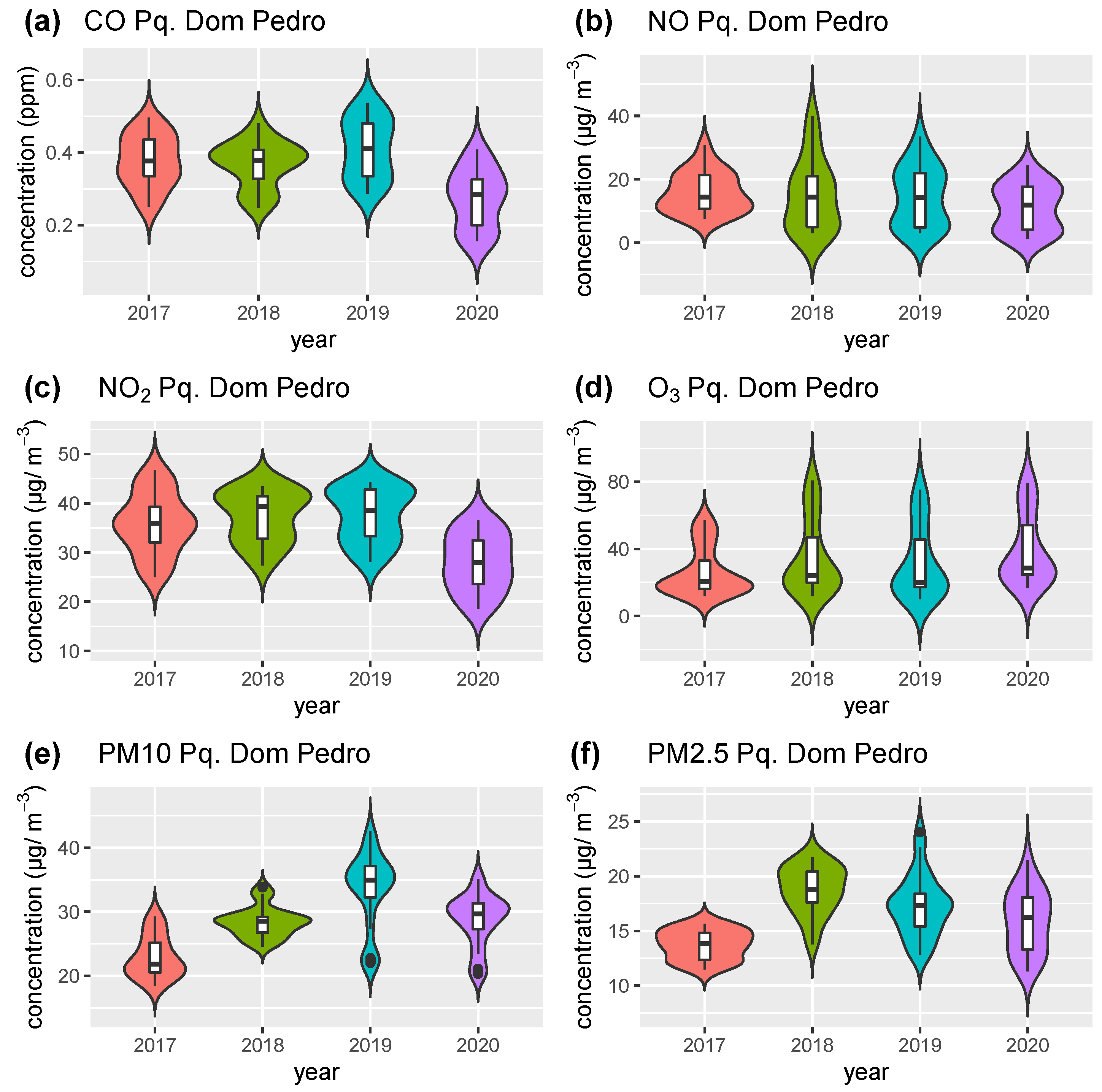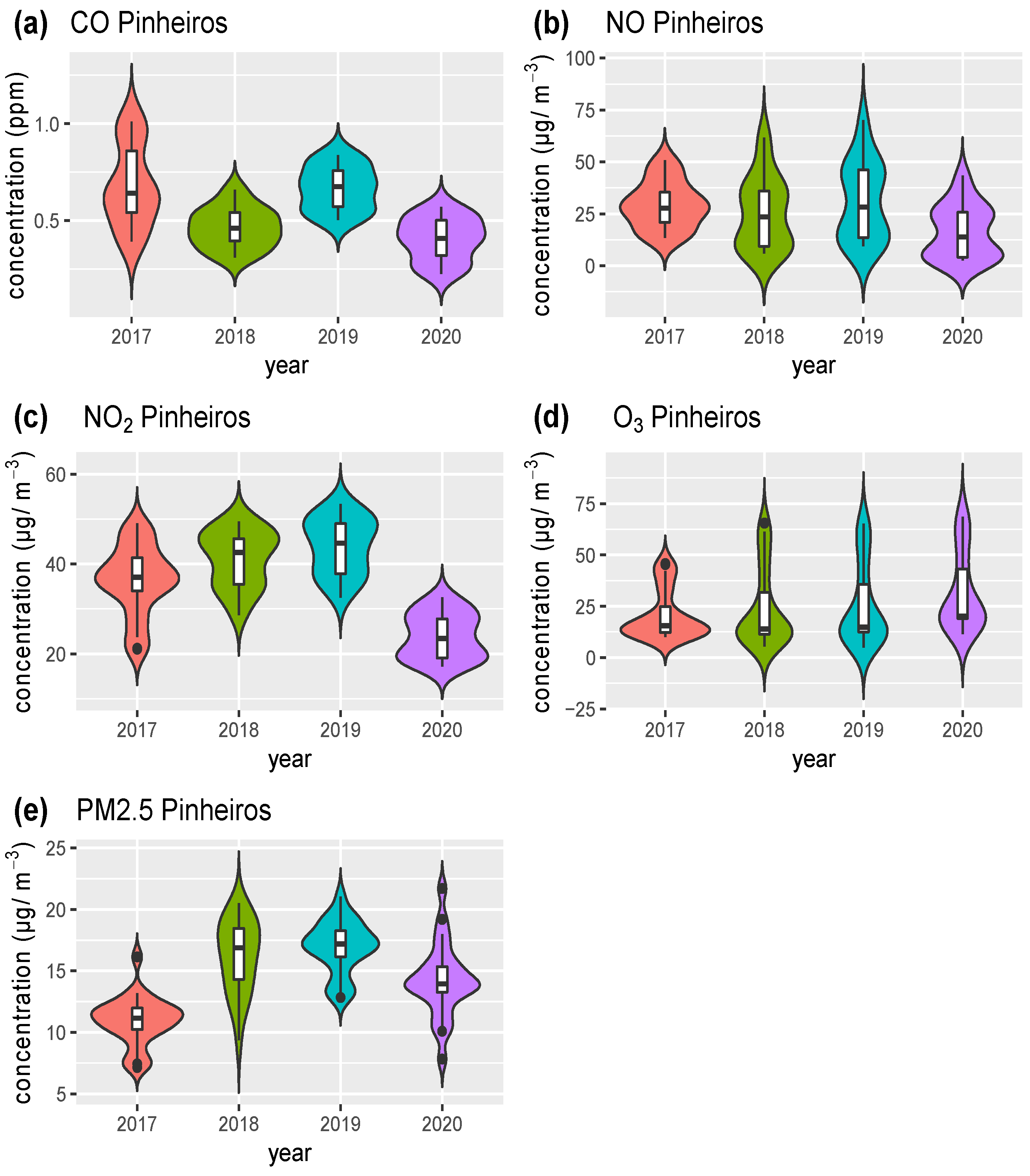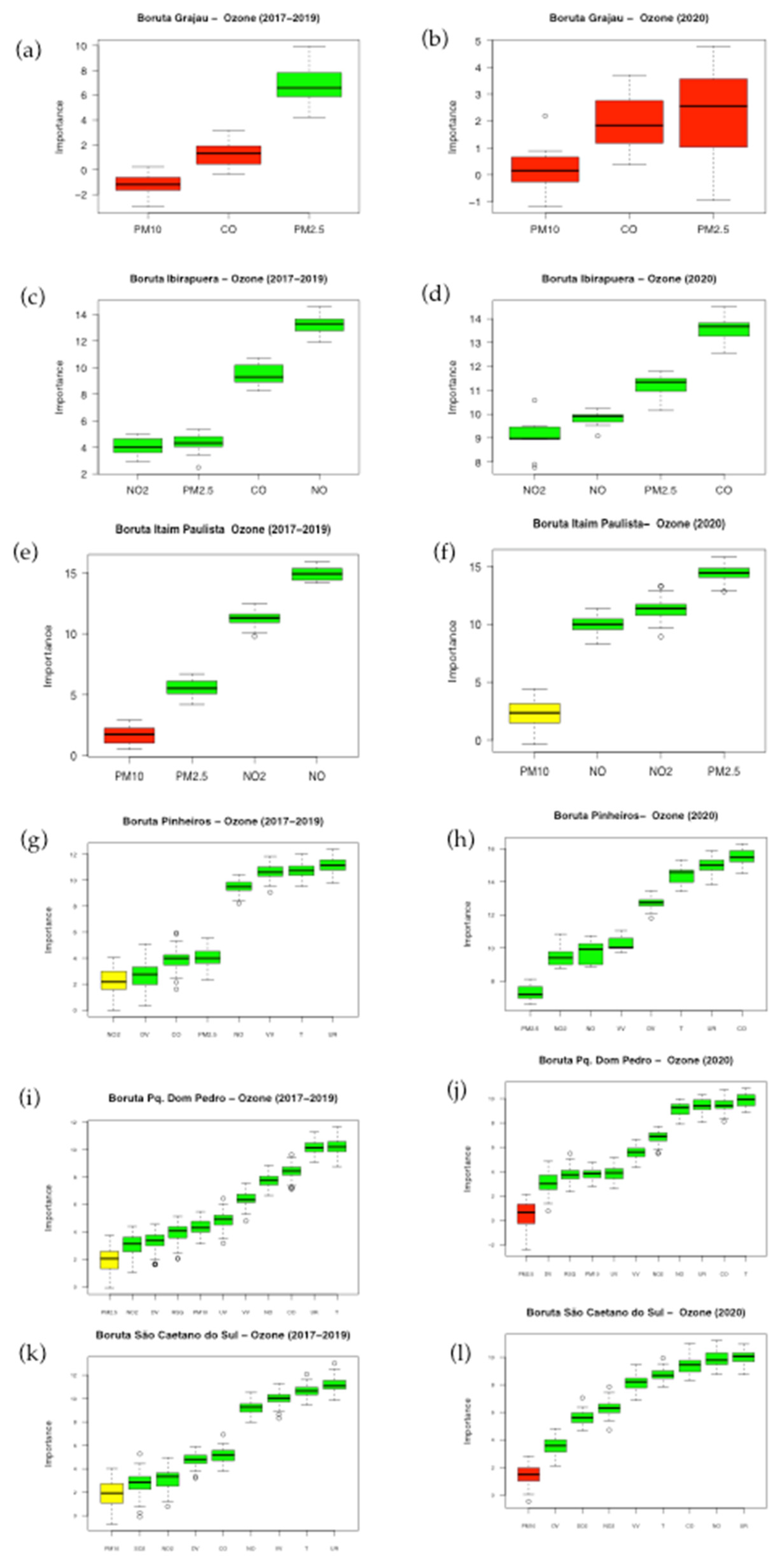1. Introduction
Owing to the lockdowns imposed during the COVID-19 pandemic, the number of vehicles circulating in large cities has fallen considerably. With fewer vehicles on the roads and companies operating at a reduced capacity, there has been a reduction in the emissions of nitrogen oxides (NOx), carbon monoxide (CO), volatile organic compounds (VOCs), and carbon dioxide (CO
2) in the atmosphere. The transport sector is an important emission source of air pollutants and greenhouse gases in the Metropolitan Area of São Paulo (MASP), where there is a fleet of around 7 million vehicles. In the MASP, both mobile and fixed sources were responsible for atmospheric emissions of approximately 120, 35, 70, 5, and 7 thousand tons of CO, VOCs, NOx, PM, and SOx, respectively, in the year 2019. Of these totals, 97%, 75%, 62%, 16%, and 40% of CO, VOCs, NOx, Sox, and PM, respectively, came from vehicular emissions, according to the CETESB Report of the Environment Agency of the State of São Paulo [
1].
On 11 March 2020, the World Health Organization (WHO) declared COVID-19—a disease caused by the new Coronavirus SARS-CoV-2—a global pandemic [
2]. In Brazil, the first case of COVID-19 was confirmed on 26 February 2020, in the state of São Paulo. By the end of 2021, there had been 22.2 million confirmed cases in Brazil, the majority being reported in São Paulo, i.e., of 4.4 million confirmed cases [
3], it had the highest number in the country (i.e., 976,918) [
4].
Brazil declared COVID-19 a public health emergency on February 3 [
5], and São Paulo and Rio de Janeiro were the first states to impose social restrictions and encourage social isolation. On 24 March 2020, the partial lockdown was imposed by the São Paulo State government, which involved the closure of shopping malls, restaurants, gyms, elementary schools, high schools, and universities. Restrictions were introduced involving social distancing in supermarkets and drugstores, and a reduced schedule for public transport services, in addition to the adoption of a ’work at home’ office system, when possible. Thus, the interruption or reduction of several activities that might potentially cause pollution could mitigate the effects of air pollution on the health of the general public [
6].
In terms of public health, a reduction in air pollution is directly proportional to a fall in the number of people with respiratory problems. In the wake of the lockdown brought about by the COVID-19 pandemic, fewer people suffered from respiratory problems, such as asthma, bronchitis, allergies, or cardiorespiratory diseases. The benefits to health brought about by the absence of sources of airborne contaminants underline the need to determine the nature of these pollutants in the atmosphere.
Moreover, the pollutants emitted by a certain country or locality are not restricted to the particular region in which they originate; they can cause damage beyond its borders. According to the World Health Organization (WHO), 92% of the world’s population lives in regions where air pollution levels exceed the limits laid down in its guidelines. About four million deaths per year can be attributed to exposure to the effects of air pollution on the environment, with 90% of them occurring in low- and middle-income countries. The Global Burden of Disease Study (2015) shows that air pollution is directly linked to 19% of deaths from cardiovascular disease worldwide, 24% from ischemic heart disease, 23% from lung cancer, and 21% from strokes [
7].
Atmospheric chemistry plays a crucial role in the spread of radioactively active gases and aerosols [
8]. In addition, climate variability and its patterns strongly influence atmospheric chemistry and air quality [
9]. Owing to the non-linear behavior of chemistry and the important regional variations of emissions, it is essential to study the evolution of trace gases through remote sensing and compare them with observations from ground stations, measurements carried out by aircraft, and state-of-the-art models [
10].
Air quality monitoring by satellite is carried out to estimate emissions, track pollutant plumes, ensure air quality, make forecasts of climate change, highlight extreme meteorological events, monitor long-term regional trends, and validate the data of the air quality models [
10].
There is currently a wealth of atmospheric composition satellite data for air quality (AQ) applications that have proven to be valuable to environmental professionals: NO
2, SO
2, NH
3, CO, some VOCs such as formaldehyde and glyoxal, and aerosol optical depth (AOD), from which surface particulate matter (PM2.5) can be inferred [
10].
The use of remote sensing in air quality studies has still only been explored to a limited extent, but is of great potential value, since some environmental satellites, such as TERRA (through the MOPITT sensor (CO) and (CH
4), MODIS and MISR (AOD), AQUA with AIRS sensor and the TANSO-FTS sensor on board the GOSAT satellite), have served as alternative and supplementary tools for monitoring the emission of pollutants. These tools have global coverage and provide the public with information on atmospheric composition and surface attributes [
11,
12,
13,
14,
15,
16,
17].
A study carried out by the University of Toronto (UT) found that there was a 40% reduction in air pollution in cities that declared a state of emergency in February 2020, i.e., Wuhan, Hong Kong, Kyoto, Milan, Seoul, and Shanghai. This study, which was conducted by Marc Cadotte of UT, analyzed the air quality index (AQI) for each of the six cities affected by COVID-19 that introduced emergency measures in February 2020 [
18]. The authors compared the 2020 AQI in these cities with that of February 2019 and found that all six cities showed a significant reduction in air pollutant concentrations during this year. However, in the case of the O
3 concentration in MASP, there was a 30% increase, which was probably due to a 77.3% decrease in NOx concentration, according to a study carried out in São Paulo [
19]. Compared with the figures for previous events that had recently taken place in Brazil, such as the truck drivers’ strike between 21 and 31 May 2018, and also compared with the average for the same period from 2015 to 2017, there was a 31% decrease in CO, 38% in NO, and 31% in NO
2, but an increase in O
3 of 65% [
20]. This increase in ozone can be attributed to the fall in NO levels, which react with O
3 to form NO
2 and O
2, the main consumption path of tropospheric O
3. The [
21] study on the truck drivers’ strike, which examined 7 stations in the MASP over a period of four years, found a 50% reduction in the averages of CO and NO and a 40% increase in O
3, while the results for NO
2 and PM were mixed—which suggests sources other than vehicular are important, such as secondary reactions and the movement of pollutants from surrounding regions.
Improvements in air quality, which are linked to social distancing measures and a resulting reduction in vehicular traffic, have been reported in recent research. In Bangladesh, air pollutant data from a NASA satellite was used to make maps, and this was supplemented by Air Quality Monitoring Station (AQMS) data to assess air pollution during the pre-lockdown, lockdown, and post-lockdown periods of the COVID-19 pandemic. As a result, considerable improvements in a wide range of air quality parameters such as NO
2, O
3, CO, SO
2, PM2.5, PM10, AOD, and black carbon emissions were observed during the lockdown period [
22]. For example, [
23] relied on the Copernicus Atmosphere Monitoring Service to analyze fine particulate matter (PM2.5) data in China and observed a reduction of approximately 20–30% in February 2020 (monthly average) compared with monthly averages for February 2017, 2018, and 2019. The authors of [
24] made use of the Copernicus Tropospheric Monitoring Instrument and data from a traffic station in Barcelona (Spain), provided by the local air pollution monitoring service, to assess changes in air quality during the lockdown in the city of Barcelona. They observed a reduction of 31% and 51% of PM10 and NO
2, respectively, during the lockdown compared with the month before the lockdown. The authors of [
25] also analyzed local data from different regions of India to assess the effects of lockdowns on air quality. The authors observed a 43% and 31% reduction in PM2.5 and PM10, respectively, during the lockdown compared with the same period in the preceding four years. Other global regions showed a reduction in pollutants during the lockdown. For instance, on the basis of satellite data, it was found that NO
2 and AOD were reduced by approximately 20% during the lockdown in 2020 in India, in comparison with the figures for the previous five years (2015–2019) [
26], while there was also a reduction in PM2.5 and NO
2 ground-based observations for the same period in seven Indian cities (except Mumbai, central India).
In the case of different regions of Poland, including urban areas and background sites, the PM2.5 and NO
2 during 2020 were lower (from 15 to 20% and from 18 to 30%, respectively) than the 10-year average [
27]. On the basis of data from Sentinel-5P and Himawari-8, there were considerable changes in NO
2, HCHO, SO
2, CO, and AOD in many Asian cities from February 2020 to the previous year [
28]. NO
2 decreased from 4% to 83%, and AOD decreased by 62%. The authors also showed that meteorological weather conditions could not explain the main variations in the pollutants. In the metropolitan area of Toronto, Canada [
29], the levels of NO
2 decreased by approximately 35 to 40% during March and June 2020 compared with the previous 7 years, particularly within the region of the airport.
The variation in meteorological parameters and the relationship with the spread of daily cases of COVID-19 (from 1 April to 30 September 2020) in the four Indian megacities Delhi, Mumbai, Pune, and Ahmedabad, which differ in their climatology, were observed in the study by [
30]. It was noted that weather variables such as relative humidity and absolute humidity showed a moderate positive correlation with daily COVID-19 cases in three cities (Delhi, Mumbai, Pune). There was a weak correlation between atmospheric temperature in Ahmedabad and Delhi, and a negative correlation was observed in the hill of Pune and the coast of Mumbai, which indicates that the lower temperature increased transmission. PCA analysis in this work revealed that COVID-19 cases are closely correlated with humidity [
30].
The aim of this study was to assess how far the partial lockdown affected the air quality in the MASP, which is the largest metropolitan region in Brazil, with around 22 million inhabitants, and one of the ten most populous metropolitan regions in the world. The lockdown was imposed to ensure that the necessary social distancing required by the COVID-19 pandemic was maintained. The analysis of CO, NO, NO2, O3 and PM2.5 pollutants was conducted by means of diurnal cycles from the lockdown period in April and May 2020, and the findings were compared with the average for the same period in the three previous years (2017–2019), when there was no pandemic. Meteorological data for the same period for MASP were also analyzed to determine the role of weather conditions in the concentration of pollutants within the context of the pandemic. These were supplemented by pollution maps, which were designed on the basis of data from the OMI sensors and MERRA-2 reanalysis for the south-east region of Brazil.
3. Results and Discussion
Significant improvements in air quality were observed in the urban area in light of the reductions in air pollutants monitored in areas that are highly influenced by vehicular traffic in MASP and MARJ, as shown in
Figure 3, for NO
2 from the OMI sensor. There was a reduction in NO
2 concentrations from 10% to more than 60% in the MASP and MARJ, whereas the figure was around 10% in MABH and MAV. As Brazil is a country with 8.5 million km
2, the initial serious effects of the COVID-19 pandemic were felt in the states of São Paulo and Rio de Janeiro, and then spread to other regions of the country, particularly the more populous cities.
Figure 4 shows the CO near-surface concentrations from MERRA-2, where there was a CO decrease of around 10% during the pandemic over almost the entire São Paulo state, especially on the border between the states of São Paulo and Rio de Janeiro, where it was accompanied by a decrease in the traffic flow of both light and heavy vehicles in this region. Small changes in CO were observed in Belo Horizonte and Vitoria, which suggests that these cities were less affected by pandemic restrictions, largely because partial lockdowns were imposed in these localities for shorter periods than in other regions in São Paulo.
Figure 5 shows the SO
2 near-surface concentrations from MERRA-2, 5 to 10% lower SO
2 concentrations were found in the MASP and MARJ, and in the west of MABH, there was a decrease of 30 to 50% on the border between the states of São Paulo and Rio de Janeiro. There was an increase in the SO
2 pollutant in the MAV region during the period under study since the pandemic did not significantly affect the air quality.
Figure 6 shows the surface BC concentrations from MERRA-2, with a 5–10% decrease in the MASP and on the border between the states of São Paulo and Rio de Janeiro, probably due to the reduction in diesel-powered truck traffic. In contrast, in the MABH and MAV, there was no reduction in this pollutant, mainly because, as stated earlier, these regions were less affected by the pandemic.
The meteorological parameters of the AQMS of Parque Dom Pedro and São Caetano do Sul were analyzed from the 6 MASP stations that were used to compare the concentration of pollutants at MASP, in April and May 2020 (pandemic) with the same period from 2017 to 2019 (pre-pandemic), since only these two stations have meteorological data for temperature, relative humidity, wind speed, and global solar radiation. The precipitation data were obtained from an INMET station close to these stations, where these meteorological variables and the pollutant concentration data were measured.
Supplementary Figures S1–S5 show the difference in weather conditions during the period of this study (April and May 2020) with the same period in the previous three years (April and May 2017, 2018, and 2019).
Figure S1 shows that the temperature during the April and May period of the pandemic in 2020 was lower in the two stations that measure this variable, while the hourly average air temperatures were 7.1% and 16.3%, which is lower than the same pre-pandemic period.
Figure S2 shows the lowest relative humidity during the pandemic period (the hourly average for April and May 2020) compared with the pre-pandemic period (the same average period from 2017 to 2019), and the relative levels of humidity were 9.4% and 8.8% lower at the Parque Dom Pedro and São Caetano stations, respectively.
Figure S3 shows that there was practically no significant variation in wind speed when the pandemic and pre-pandemic periods of this study were compared; at the São Caetano do Sul station, there was an increase in wind speed from 10 am to 14 pm. The wind speeds were 1.4% and 0.6% lower at Parque Dom Pedro and São Caetano stations, respectively. Global solar radiation was 14.3% higher at Parque Dom Pedro station, as shown in
Figure S4. As can be seen in
Figure S5, the total precipitation that occurred in the period of this study during the pandemic in April and May 2020 is the lowest recorded when compared with previous years (2017–2019), similar to 2018, but even lower in the other years. The slight difference in temperature, relative humidity, wind speed, and global solar radiation, as well as the considerable reduction in precipitation during the pandemic period compared with the prior period, indicate that the pollutant reductions observed during the pandemic period were not determined by changes in dispersion conditions.
Figure 7 shows the hourly average rate of CO concentrations for April and May 2017, 2018, and 2019 (the pre-pandemic period) and for the same months in the year 2020 (during the pandemic) for 5 AQMS from MASP.
It can be seen in
Figure 7 that the daily temporal pattern of CO concentrations did not change during the two periods. In the MASP, 97% of the CO emitted comes from vehicular emissions, which explains the increase in concentrations from 6:00 a.m. to 9:00 a.m., the time of greatest traffic density. After this time, concentrations decline, and there is an increase again from 5:00 p.m. to 8:00 p.m., which coincides again with the second peak of traffic in the MASP.
Figure 7 also shows an average reduction of 77.4%, 14.7%, 48.7%, 41.1%, and 12.1% in CO concentrations for the monitoring stations of Grajaú-Parelheiros, Ibirapuera, Pinheiros, Parque Dom Pedro, and São Caetano do Sul, respectively, as well as for the Ibirapuera station, where the campaign hospital specializing in COVID-19 care was located. The Ibirapuera station is located further away from the vehicular source of pollution; it is a region where primary pollutants have lower concentrations than stations near the main roads, although the secondary pollutant, O
3, is high in this location.
A study carried out using data from the CETESB AQMS in the city of São Paulo and Cubatão (on the southern coast of São Paulo State) compared data from the period of partial lockdown during April 2020 with the April monthly average of the previous five years (2015, 2016, 2017, 2018, and 2019) [
19]. The study reported a decrease in CO concentrations of 53.1% and 64.8%, respectively, from measurements carried out in the city of São Paulo [
19]. In another study carried out in the city of Rio de Janeiro, which compared 30 days from mid-March to the first half of April 2019 with the same period in 2020, there was a reduction of 38% and 36.4% in the concentration of CO in the regions of Bangú and Tijuca, respectively [
45].
Figure 8 shows the hourly average NO concentrations for the April-May period for 2017, 2018, and 2019 (pre-pandemic) and the April-May period for 2020 (during the pandemic).
According to the results in
Figure 8, the Ibirapuera station had a NO concentration reduction of 47.3% when compared with April-May for 2020 (during the pandemic) and April-May for 2017, 2018, and 2019 (pre-pandemic). It can be concluded from this that there was less diesel traffic near this station, since 48% of NOx emissions in the MASP come from heavy and diesel-fueled vehicles [
46]. At the Itaim Paulista station, there was a reduction in NO concentrations of 19.2% compared with the average pre-pandemic level, as heavy vehicle traffic in this region is lower than in the other AQMS used in this study. At the Parque Dom Pedro and São Caetano do Sul stations, there was a reduction in NO levels of 37.0% and 45.5%, respectively. In the case of the Pinheiros station, there was a reduction in NO concentrations of 75.6%. In general, NO concentrations during the pandemic were lower, particularly at the Pinheiros and Parque Dom Pedro stations, which are close to roads with heavy traffic. Pinheiros station is close to one of the main roads in the city of São Paulo (Marginal Pinheiros) with a high rate of truck traffic, and Parque Dom Pedro station is close to an urban bus terminal that uses diesel fuel. Traffic emissions from heavy diesel vehicles are the primary source of NO [
1,
46,
47]. The times with the highest concentration, both in the periods with and without a lockdown, were the peak hours of vehicular traffic, from 7:00 to 11:00 a.m. and from 7:00 p.m. onwards. This is when concentrations increase as a result of vehicular emissions but decrease at the height of the planetary boundary layer, owing to a lack of O
3 production at night (which consumes NO during the day).
A previous study using data from the CETESB AQMS in the cities of São Paulo and Cubatão (on the south coast of São Paulo State) compared data during the pandemic and pre-pandemic periods and found there was an increase in NO concentrations of 8% for Cubatão, where the largest Latin America industrial hub is located, with fertilizer, steel, chemical, and petrochemical companies, while at São Paulo city there was an average decrease of 75% in NO concentrations [
19].
Figure 9 shows the NO
2 mean average hourly concentrations during the pandemic and pre- pandemic periods.
NO2 concentrations were 21.6% lower at the Itaim Paulista station during the pandemic period. Parque Dom Pedro and São Caetano do Sul had a NO2 reduction in hourly averages of 31.9 and 44.3%, respectively. Pinheiros station, located near a road with heavy vehicular traffic, had the highest NO2 reduction in the lockdown period (69.6%).
Ibirapuera station had a reduction of 26.1%. There was an increase in NO2 concentrations during the morning from 6:00 to 10:00 a.m. in both periods (i.e., during the pandemic and pre-pandemic periods), as a result of vehicular emission, but also secondary NO2 was formed in the atmosphere through the oxidation of NO with O3, and also by the oxidation of VOCs radicals with NO. NO2 concentrations decreased from 12:00 to 16:00, which coincides with the period of higher O3 concentration in the MASP. This period also had greater solar radiation, as it is the time when NO2 is undergoing photolysis reaction, and forming NO and atomic oxygen. NO2 concentrations increased again after 6:00 p.m., as this was the peak period of vehicular traffic.
A similar comparison was made by [
19], for both periods, i.e., during the pandemic and pre-pandemic periods, when there was a decrease in NO
2 concentrations of 48.6% and 72.7% at two monitoring points in the city of São Paulo. Similarly, in the case of Cubatão, there was a reduction of only 5.6% in NO
2 concentrations [
19], which underlines the importance of industrial sources of NOx. Hence, there was not the same fall in NO
2 concentration as during the truck drivers’ strike in the year 2018, which led to lower vehicle emissions, even when companies continued to operate [
21].
In a study carried out in the city of Rio de Janeiro, which involved comparing the last half of March with the first half of April 2019 with the same period for 2020, there was an average reduction in NO
2 level of 27% and 24% in the region of Bangú and Tijuca, respectively [
45]. The less significant NO
2 reduction with regard to CO and NO demonstrates its lower reactivity and underlines the importance of this pollutant’s secondary fraction in the MASP.
Figure 10 shows the mean average hourly O
3 concentrations during the pandemic and pre-pandemic periods. When both these periods are compared, there was an increase in O
3 concentrations of 27.3% in Ibirapuera, 21.5% in Itaim Paulista, 26.1% in Pinheiros, 21.1% in Parque Dom Pedro, 19.4% in São Caetano do Sul, and a reduction of O
3 of 19.5% at the Grajaú-Parelheiros station, an atypical behavioral pattern, since in the MASP, when NOx concentrations decrease, there is usually an increase in O
3 [
21,
48,
49,
50,
51]. It would have been useful to have the NOx data for the Grajaú-Parelheiros station for further analysis, but there was no NOx-measuring device at this monitoring point.
The O
3 concentration starts to increase after 9:00 a.m. owing to the emission of primary pollutants and their precursors, such as CO, VOCs, and NOx, in the early morning hours, which coincide with the peak time of vehicular traffic. The formation of O
3 occurs later after the emission of primary pollutants and after the availability of sunlight, and reaches its maximum concentration from 1:00 p.m. to 3:00 p.m. At nighttime, O
3 is no longer formed due to the lack of sunlight, thus NO
2 is formed from NO (Reaction 3), which is a predominant traffic source, as this takes place in MASP. NO
2 and O
3 react to form NO
3 (Reaction 4). At nighttime, N
2O
5 can be formed through a reaction of NO
2 and NO
3 (Reaction 5) and decomposes at a rate coefficient k−3, and hence N
2O
5 [
52,
53,
54].
The reduced O
3 production is overwhelmed by the weakened nitric oxide (NO) titration resulting in a net increase of O
3 concentration. Although the reduction in emissions of NO increases O
3 concentration, it leads to a decrease in the Ox (O
3 + NO
2) concentration, which is a sign of reduced atmospheric oxidation capacity on a regional scale. The dominant effect of NO titration underlines the importance of prioritizing VOCs [
52].
Figure 11 shows the mean hourly PM2.5 concentrations during and prior to the pandemic period. It was noted that PM2.5 behaved in a different way from CO, NO and NO
2 which had lower concentrations in practically all the air quality monitoring points in this study. PM2.5 had a reduced concentration at the Ibirapuera station at all times during the pandemic period. At the Itaim Paulista station, there was an increase in the PM2.5 concentration from 9:00 p.m. to 11:00 a.m. during the pandemic period, and then the concentration decreased from 12:00 p.m. to 8:00 p.m. At Grajaú-Parelheiros station there was a large decrease in PM2.5 from 9:00 to 15:00. At Pinheiros station, there was an increase in PM2.5 concentrations from 12:00 to 19:00 during the pandemic. At Parque Dom Pedro and Grajaú stations no quantitative differences were found between the pandemic and pre-pandemic periods. In light of the average level of PM2.5 concentrations, when both periods are compared, there was a reduction at the stations of Grajaú-Parelheiros (3.7%), Ibirapuera (30.1%), and São Caetano do Sul (20.7%). In the case of Itaim Paulista station, when the average of all the times is taken into account, there is no significant difference between both periods (just an increase of 2.9%), a decrease from 12:00 p.m. to 08:00 p.m. and an increase in concentrations from 09:00 p.m. to 11:00 a.m. With regard to the Parque Dom Pedro station, there was an average decrease of 4.6% during the pandemic period.
In
Supplementary Materials Figure S6, there is a comparison between the AOD value of the AERONET station, located in the city of São Paulo, close to the AQMS (which used the pollutant concentration data provided in this work), and the MERRA-2 data. The AERONET versus MERRA-2 data from April and May (2017 to 2019—pre-pandemic) and the same period in 2020 (pandemic) show that the MERRA-2 data are underestimated when compared with the data from AERONET. When only the AERONET data are taken into account, the AOD value is 46% lower in the pandemic period than in the pandemic period, which is evidence that there was a reduction in the concentration of aerosols in the pandemic period.
On the basis of data obtained from six terrestrial air quality measurement stations, this work has shown that gases emitted by primary sources, such as CO and NO, decreased by 38.8% and 44.9%, respectively, in the period of April and May 2020 (pandemic), compared with the same period for 2017–2019. Additionally, NO
2 and PM2.5 were reduced by 38.7% and 6%, respectively, while O
3 increased by approximately 16% in the same period. The AERONET AOD values were 46% lower in the pandemic period than in the period without a pandemic. No significant changes in the meteorological variables could explain these pollution variations. The results showed that temperature, RH, and wind speed decreased by 11.7%, 9.1%, and 1%, respectively, during the pandemic period. Rainfall and global solar radiation were 7 times and 14.3% lower, respectively, for the pandemic period. Meteorological conditions could not explain the decrease in MASP pollutants, such as CO, NO, NO
2, PM2.5, as observed in
Figure S5 during the period of this study from April and May 2020 during the pandemic. Compared with April and May of the three previous years without a pandemic (2017, 2018, and 2019), precipitation was 7 times lower during the pandemic than in the pre-pandemic period, so it was expected that there would be less precipitation since there was an increase in pollution in the pandemic period, but the opposite occurred even though there was much lower precipitation in the pandemic period. Otherwise, the lower number of people on the roads resulting from the partial lockdown could largely explain these anthropogenic reductions in emissions, mainly caused by vehicles. According to the Environmental Agency of São Paulo State (CETESB), the main MASP atmospheric pollutant emissions are from vehicle sources, which account for approximately 97%, 75%, 62%, 16%, and 40% of CO, VOCs, NOx, SOx, and PM, respectively. Thus, it is clear that a reduction in the use of vehicles could significantly affect the air quality of the study area.
Figure 12a displays the violin graphs for Grajaú station from the four years studied for CO. The year 2020 during the pandemic period has the lowest median, with upper and lower limits and lower outliers than is the case in the pre-pandemic period. In the case of O
3 in
Figure 12b, the median is slightly higher during the pandemic in the year 2020 than in the year 2019, but lower than in the years 2017 and 2018, whereas the data distribution is similar in the year 2020 when this is compared with the years 2017 and 2018. With regard to PM10 (
Figure 12c), the year 2020 has a median similar to the year 2019, but a different distribution from the data in the year 2020, with higher upper and lower limits in the year 2020 than the years of the pre-pandemic period. In the case of PM2.5 (in
Figure 12d), the year 2020 has a median similar to that of the years 2018 and 2019, but a different distribution of data, with higher upper and lower limits in the year 2020 than the years of pre-pandemic.
Figure 13 shows the violin graphs for the Ibirapuera station. In
Figure 13a, during the pandemic (in 2020), CO has a median concentration lower than that in the year 2019, but higher than 2017 and 2018. With regard to NO and NO
2 (
Figure 13b,c), there is a lower median concentration than in the pre-pandemic period (namely, 2017, 2018, and 2019). The median for O
3 during the pandemic period (2020) is higher than in the pre-pandemic period owing to a decrease in NO (in 2020), a pollutant that consumes O
3. PM2.5 is lower during the pandemic (2020) than in the pre-pandemic period.
Figure 14 shows the violin graphs for the Itaim Paulista station. There is no significant variation in the concentration of NO, as shown in
Figure 14a, compared with the pandemic year (in 2020) with the years 2018 and 2019. The NO
2 (
Figure 14b) has a lower median concentration than in the years 2018 and 2019. On the other hand, O
3 (
Figure 14c) has a slightly higher median concentration in the year 2020 compared with other years. The PM10 (
Figure 14d) during the pandemic (in 2020) does not show any significant difference in the median concentration than in the pre-pandemic period (2017–2019). PM2.5 (
Figure 14e) has a higher median concentration during the pandemic 2020 than the pre-pandemic period.
Figure 15 shows the violin graphs for the median of pollutants for the Parque Dom Pedro station. In
Figure 15a for CO, the year 2020 of the pandemic has a lower median than in the pre-pandemic period, but the data distribution is similar for all the years. In
Figure 15b, for NO, the median is similar during the pandemic (in 2020) to the pre-pandemic period. In
Figure 15c, NO
2 has a lower median and lower limit during the pandemic than in the pre-pandemic period. In the case of O
3,
Figure 15d indicates a slightly higher median during the pandemic than in the pre-pandemic period, but a similar data distribution for all the years of the study. In
Figure 15 for PM10, the median is lower in 2020 than in 2019, but higher in 2017 and 2018.
Figure 15f indicates that PM2.5 had a lower median in 2020, during the pandemic, than in 2018 and 2019, during the pre-pandemic period, and a lower limit during the pandemic period (in 2020).
Figure 16 displays the violin graphs of the median of pollutants for the Pinheiros station. In
Figure 16a–c for CO, NO and NO
2 the concentrations are lower in the year 2020, during the pandemic. This station is located close to Marginal Pinheiros, one of the main transit routes in the MASP, which is why there was a reduction in these pollutants. As it is a station close to the vehicular emission source, there is no significant variation in the secondary pollutant O
3 in the pandemic year. PM2.5 is lower in 2020 than in 2018 and 2019, but higher than in 2017.
Figure 17 displays the violin graphs for São Caetano station.
Figure 17a,b shows CO and NO, respectively. The year 2020 during the pandemic has the lowest median, but the data distribution is similar for all the years in this study (i.e., 2017–2020).
In
Figure 17c, NO
2 has a lower median in 2020, during the pandemic, with reduced upper and lower limit values.
Figure 17d shows O
3 with a higher median in 2020, during the pandemic, than in the pre-pandemic period, but with a similar data distribution.
Figure 17e indicates the SO
2 with the lowest median in 2020, during the pandemic, but it is not very different from the 2019 value.
Figure 17f for PM10 shows a lower median in 2020 (during the pandemic) than in 2018 and 2019 (during the pre-pandemic period). Overall, in the case of the MASP AQMS (
Figure 12,
Figure 13,
Figure 14,
Figure 15,
Figure 16 and
Figure 17), the violin graphs have a lower median concentration of CO, NO, and NO
2 for the pandemic period (April and May 2020) than for the pre-pandemic years (April and May 2017, 2018, and 2019), ozone has a higher median in the year of the pandemic owing to the reduction in NO that consumes O
3. CO, NO, NO
2, and O
3 have a similar distribution for the entire study period, while SO
2, PM10 and PM2.5 have a data distribution with a different pattern during the years 2017 to 2020.
Figure 18a,b shows the importance of using the Boruta algorithm for pollutants with regard to tropospheric O
3, since Boruta is a well-tested resource selection method. It is designed to capture all the important and useful features you might have in your dataset with regard to an outcome variable. In this case, the study variable is the ozone concentration, and the dataset includes the other variables for the stations employed for monitoring air quality. In this study, green boxes are the most important variables for the formation or consumption of ozone, followed by the least important—yellow—and then red (medium and lower importance, respectively) [
55].
In
Figure 18a,b, the order does not change in the years during the pandemic and the pre-pandemic period, with PM2.5 and CO being the two pollutants in the Grajaú station that most influence O
3 formation. CO was the pollutant emitted in greatest abundance in the MASP, as shown in
Figure 7, since it is partly oxidized to CO
2 by the hydroxyl radical, as outlined in Reaction 6, and it generates the hydroperoxide radical (HO
2). This radical, in a similar way to peroxide radicals, which are formed by VOCs, oxidizes NO to NO
2 by competing with O
3 molecules and increasing the atmospheric concentration of this gas, as outlined in Reaction 7.
Thus, the importance of this pollutant in the formation of O
3 can be explained both at the Grajaú station and at other stations that measure CO. At the Grajaú station, (
Figure 18a,b), PM2.5 is the most important pollutant for O
3 formation in both periods, during and before the pandemic. In
Figure 18c,d (Ibirapuera station), CO was the second most important pollutant for O
3 formation in the pre-pandemic period and the first pollutant in the pandemic year. At the Pinheiros station (
Figure 18g,h), CO is the second most important pollutant in the pre-pandemic years and the first in the pandemic year. At the Parque Dom Pedro station (
Figure 18i,j), CO is the first major pollutant in the pre-pandemic years and the second in the year during the pandemic. At the São Caetano do Sul station (
Figure 18k,l), CO is the second most important pollutant for O
3 formation in both the pre-pandemic period and during the pandemic years.
Ref. [
56] showed that an increase in atmospheric oxidation could strengthen the production of secondary particles by making a contribution of up to 27% to the environmental levels of PM2.5. High concentrations of O
3, a powerful oxidant, lead to the formation of secondary particles, which can result in O
3 being important in the formation of secondary particles. The interaction between O
3 and PM2.5 is generally affected by photochemical reactions [
57]. Photolysis of O
3 generates OH·, which then oxidizes the VOCs to bring about the conversion of NO to NO
2, by breaking the photo-stationary state relationship. In addition to photochemical reactions, the heterogeneous reactions that occur on the surface of soluble particulate material and black carbon are also an important form of interaction between O
3 and atmospheric particles [
58,
59,
60].
The authors of [
61] analyzed data collected from diffuse reflectance infrared Fourier transform spectroscopy (DRIFTS) and reported that, in the presence of O
3, SO
2 could be oxidized to sulfate on the surface of CaCO
3 particles. The authors [
62] found that high concentrations of NOx can largely increase the formation of fine particulate nitrate under high O
3 and in favorable meteorological conditions. Secondary organic and inorganic aerosols generated from oxidation reactions comprise a significant fraction of particles, which has serious implications for air pollution in large cities [
63].
The authors of [
64,
65] used a box model and a three-dimensional regional chemical transport model to assess the impact of dust particles on tropospheric photochemistry over the megacity of Beijing with high concentrations of dust leveling down the O
3 environment [
66] analyzed summer O
3 formation in a megacity in northwest China and concluded that high concentrations of particulate matter can significantly reduce the photolysis frequencies with O
3 reduced by more than 50 µg·m
−3 (about 25 ppb).
High NOx concentrations can increase fine particulate nitrate formation at high O
3 levels depending on weather conditions [
62,
67]. At the Ibirapuera station, which is classified as a background station, since it is a long distance from the roads with the highest emissions of primary pollutants (
Figure 18c,d), PM2.5 was the third most important pollutant for O
3 formation in the pre-pandemic period, and in the year during the pandemic as the second most important pollutant for O
3. At the residential/industrial Itaim Paulista station (
Figure 18e,f), PM2.5 was the third most important pollutant for the formation of O
3 in the pre-pandemic period, and in the pandemic year, it was the first. At the Pinheiros and Parque Dom Pedro stations (
Figure 18h–j), PM2.5 has no significant importance in O
3 formation. As these two stations (Pinheiros and Parque Dom Pedro) are close to the main roads in the MASP, with higher concentrations of primary pollutants such as CO and NO, there is no time for the formation of high O
3 concentrations and their interaction in the formation of fine and secondary particles, such as PM2.5. The background stations (Ibirapuera) and Itaim Paulista (residential/industrial), are far away from traffic routes with high emission rates of primary pollutants during the pandemic year, and thus PM2.5 has become more important in O
3 formation than NO. During the pandemic year, there was a decrease of 47.3% and 19.2% in NO at the stations of Ibirapuera and Itaim Paulista, respectively, with regard to the NO pollutant during the pandemic when compared with the pre-pandemic period. An increase of 27.3% in O
3 for the Ibirapuera station and 21.5% in O
3 at the Itaim Paulista station reduced the concentration of NO that consumes O
3 and increased the interaction of O
3 with the formation of PM2.5 particles.
At stations that measured NO (Ibirapuera, Itaim Paulista, Pinheiros, Parque Dom Pedro, and São Caetano do Sul), in the pre-pandemic period, NO was the most important for O
3 concentration. In this case, the consumption will later be formed of NO
2, which will undergo photolysis and form O
3 again (
Figure 18c,e), and during the pandemic, this was the third most important pollutant (
Figure 18d,f). At the Pinheiros station, NO is the first most important pollutant in the pre-pandemic period and the second most important pollutant during the pandemic year with regard to O
3 formation. At the Parque Dom Pedro station, NO was the second most important during the pre-pandemic period and the most important during the pandemic year. At the São Caetano do Sul station, NO was the most important in O
3 formation in both periods, i.e., during the pandemic and pre-pandemic. At Ibirapuera station, there was a reduction of 47.3% in NO concentrations, a reduction of 19.2% at Itaim Paulista, a reduction of 75.6% at Pinheiros, a 37% reduction at Parque Dom Pedro, and a 45.5% reduction at São Caetano do Sul during the pandemic, compared with the pre-pandemic period. The NO pollutant consumes O
3 to form NO
2 and the decrease in NO during the pandemic period had the effect of increasing the O concentration. This phenomenon was also observed in Rio de Janeiro and is examined in a study [
68].
The AQMS São Caetano do Sul, classified as residential, and Ibirapuera, classified as urban background, showed the greatest reduction of PM2.5, 30.1, and 20.7%, respectively, since these two stations tend to have higher O3 concentrations, because they are far from the main routes that emit primary pollutants. The greater decrease in PM2.5 in these two stations can probably be attributed to a higher concentration of O3; perhaps NOx in these stations allows the formation of O3 rather than PM2.5. The stations of Grajaú-Parelheiros, Itaim Paulista, and Parque Dom Pedro had an average variation in the hourly concentration of PM2.5 during the pandemic, which was practically insignificant compared with the pre-pandemic period. The Pinheiros station experienced an increase of 20.5% in its average hourly concentrations during the pandemic period. This station is close to one of the main vehicular traffic routes of MASP, and was the station that had the greatest reduction in NO and NO2 and the second largest increase in O3, despite being a station with a high concentration of primary pollutants. This increase in PM2.5 can probably be attributed to a higher concentration of O3 in the formation of secondary organic particles, which led to an increase in the concentration of PM2.5.
In general, in
Figure 16,
Figure 17 and
Figure 18 the pollutants NO
2, SO
2, and PM10 had less importance in the O
3 concentration than CO, NO, and PM2.5, which were the most serious pollutants for the O
3 levels.
The key meteorological variables for tropospheric O
3 concentration in the MASP in the three stations that measure these variables were relative humidity, temperature, and wind speed. As there were no significant changes in these parameters in the years during the pandemic and pre-pandemic periods, it is impossible to compare their variables. However, it can be inferred that a rise in temperature increases the concentration of O
3 as it has a linear relationship with solar radiation. Wind intensity can lead to air masses that carry O
3 precursors or themselves. Several studies have shown a positive Pearson correlation of O
3 with temperature and wind speed and a negative correlation with relative humidity in the MASP (cf. [
69,
70]. In another study, specifically concerned with O
3, [
70] analyzed 39 large urban areas in the eastern US, which confirmed that O
3 generally increases when there is a rise in temperature and decreases when there is greater relative humidity.
